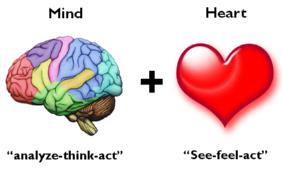When an organization undertakes a new change initiative, the project team is immediately faced with one of the most fundamental and challenging tasks – establishing a compelling sense of urgency at all levels of the organization.
This is a necessary first step in gaining stakeholder cooperation required to drive a significant change effort. Half of the companies that fail to affect needed change make their mistakes at the very beginning by not creating an appropriate sense of urgency.
Project teams often make the mistake of appealing purely to their stakeholders’ intellectual side, presenting a solid business case with lots of economic data and a “compelling” rationale. This approachappeals to the mind only (analyze-think-act). The logic goes something like this: “once people analyze the facts they will realize this change is a good and will then act in the initiative’s best interest.” The problem with failed change initiatives isn’t that the business case is poorly thought out, or not supported with sufficient facts and analysis. The fundamental problem is that the business case is all head and no heart.
In contrast, change-savvy project teams aim to inspire on an emotional level, using a see-feel-act approach which appeals to the heart. They will connect to the deepest values of their people and motivate them toward a compelling future state. They will make the business case come alive with human experience – by engaging the senses, creating messages that are simple yet imaginative, creatively articulating the vision, and calling people to aspire.
Project teams often underestimate how hard it is to drive people out of their comfort zones, or overestimate the extent to which they have already done so. In many cases, executive sponsors and teams simply lack the patience necessary to cultivate the appropriate level of urgency. It takes time to do it well, but that time is made up on the backend of the project with increased buy-in and adoption.
Without investing the time upfront to establish a strong sense of urgency, the broader organizational change effort and subsequent change activities will be significantly compromised.
In the book Switch: How to Change Things When Change Is Hard, the authors use a wonderfully descriptive metaphor of the elephant and the rider. Our emotional side is like a 20,000-pound elephant being tenuously controlled by a much smaller rider, who represents our rational side. The size difference makes it very difficult to be the rider, and struggling with an unruly animal can be very tiring.
So, if we want to change how other people behave we cannot forget that they have their own elephants and riders with which to contend. If you want to help people change their habits or initiate a change in the workplace, keep in mind that you will need to appeal to both their elephants (heart and emotion) as well as their riders (mind and rationale) when motivating them to change their work or their behavior.
----
About the Author
Jesse Jacoby is Managing Principal at Emergent (www.EmergentConsultants.com) and a recognized expert in business transformation and strategic change management. He and his team partner with Fortune 500 and mid-market companies across North America to deliver successful people and change strategies, supporting a range of business initiatives including organizational restructurings, technology deployments, strategic growth initiatives, mergers, and outsourcing.





